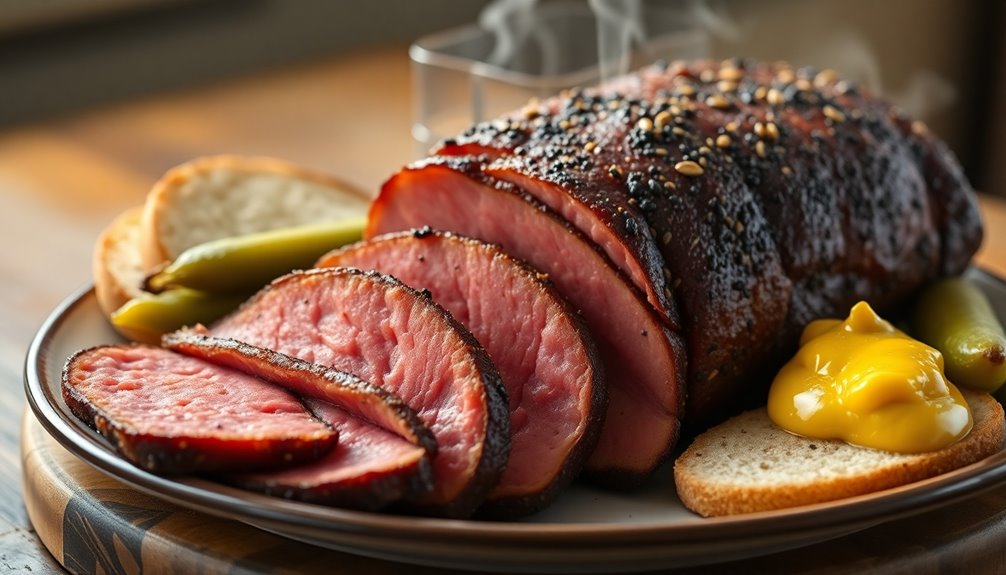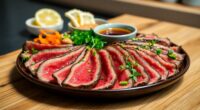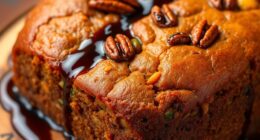Long roasted pastrami is a delicious, labor-intensive dish with a rich history rooted in Romanian meat preservation. Originating from Jewish immigrants in New York, it's made from well-marbled brisket or chuck roast, brined for flavor, and slow-cooked to tender perfection. You'll want to season it generously, bake it low and slow, and steam it for ultimate juiciness. When you slice it against the grain, you'll enjoy the melt-in-your-mouth experience. Discover more tips for that perfect pastrami!
History
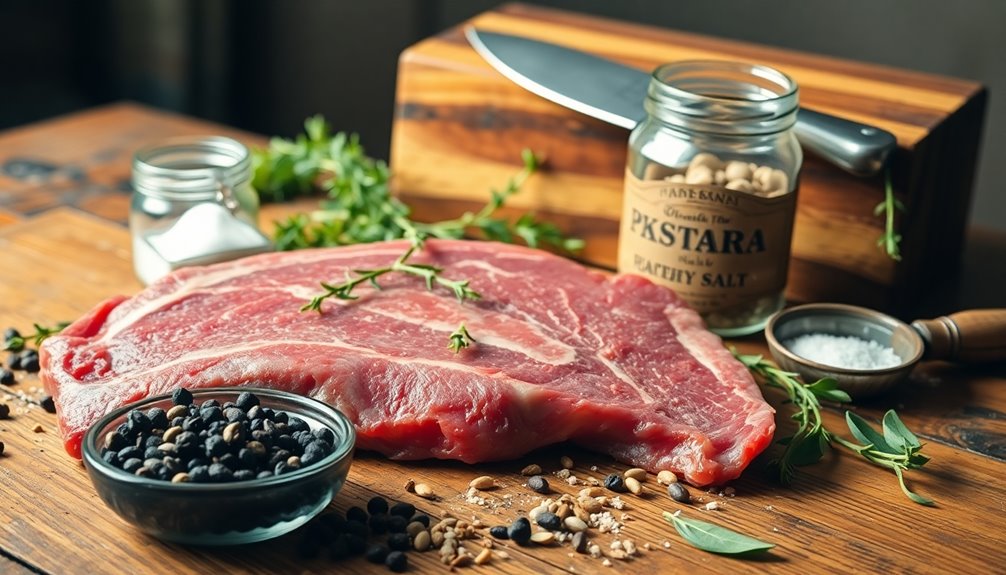
Pastrami, though it may seem like a quintessential New York dish today, actually has its roots in Romania, where it was developed as a method for preserving meat.
When Jewish immigrants arrived in New York City in the late 19th century, they brought this flavorful tradition with them. Initially made from beef brisket, pastrami reflected the culinary practices of Eastern European Jews, who used available cuts of meat.
Jewish immigrants introduced pastrami to New York, showcasing the culinary legacy of Eastern European Jews and their resourceful use of meat.
The process involves brining, followed by a spice rub and slow cooking, which gives pastrami its unique flavor and tender texture.
It quickly became a staple of Jewish American cuisine, particularly at iconic spots like Katz's Delicatessen, symbolizing New York's rich immigrant heritage and diverse culinary landscape. Additionally, its popularity can be likened to Paula Deen's wedding highlights, showcasing how culinary traditions can create memorable experiences.
Recipe
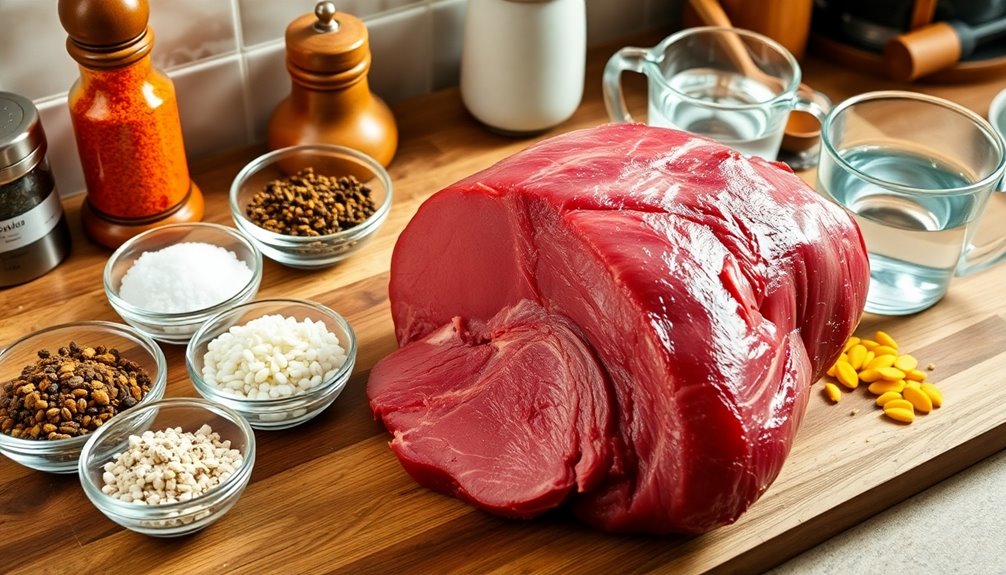
Making long roasted pastrami is a labor of love that rewards you with tender, flavorful meat that's perfect for sandwiches or served on its own. The process begins with choosing the right cut of beef; a well-marbled brisket or chuck roast is ideal for ensuring richness and moisture throughout the cooking process.
The key to great pastrami lies in the brining stage, where the meat absorbs flavors and preserves its juiciness for the long cooking ahead. After brining, the meat is coated in a spice rub that brings out its savory character, followed by a slow smoking process that imparts a distinctive flavor. The final baking phase ensures the pastrami reaches the perfect tenderness, making it a delightful dish that's well worth the wait.
Ingredients:
- 5 to 7 pounds of brisket or chuck roast
- 1 cup water
- ½ cup salt
- ½ cup sugar
- 2 tablespoons pickling spices
- 2 tablespoons toasted black pepper
- 2 tablespoons coriander
- 1 tablespoon mustard seeds
- 1 tablespoon smoked paprika
- Water for steaming
Cooking Instructions:
Begin by brining the beef in a mixture of water, salt, sugar, and pickling spices for 5 to 7 days in the refrigerator. Once brined, rinse the meat and pat it dry.
Prepare a spice rub by combining toasted black pepper, coriander, mustard seeds, and smoked paprika, then apply it generously to the surface of the meat. Let the seasoned meat rest in the refrigerator overnight.
When ready to cook, preheat your smoker to 250°F, place the meat inside, and introduce steam using pans of water. Smoke the pastrami for about 2 hours, then wrap it in foil and transfer it to an oven preheated to 275°F, baking for approximately 6 hours until the internal temperature reaches 205-210°F.
Extra Tips:
For the best results, plan ahead and ensure you have enough time for both brining and cooking. Always check the internal temperature with a meat thermometer to guarantee the pastrami is cooked to the desired tenderness. Additionally, maintaining adequate storage solutions for your ingredients will help keep them fresh and organized.
If you prefer a smokier flavor, consider adding wood chips to the smoker during the first hour of cooking. Additionally, allowing the pastrami to rest for at least 30 minutes before slicing will help retain its juices, making for a juicier and more flavorful result.
Enjoy your homemade pastrami in sandwiches, on a platter, or however you prefer!
Cooking Steps
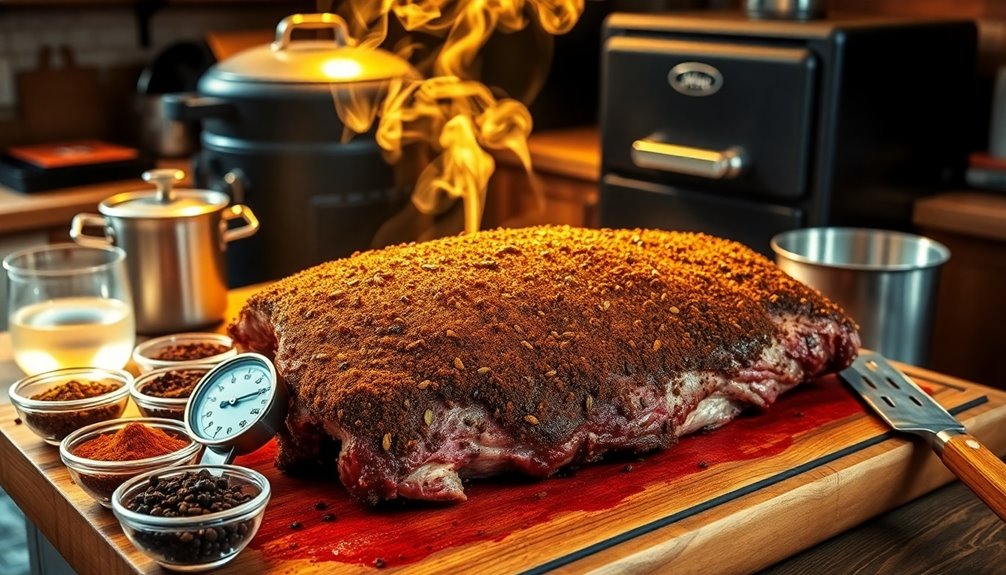
To start the cooking process, preheat your oven to 300°F.
Once it's heated, season the brisket generously with black pepper and wrap it tightly in butcher paper.
Bake it for four hours, then let it rest for 30 minutes before slicing to maximize flavor and tenderness. This dish would pair well with classic Thanksgiving side dishes like corn on the cob or green bean casserole for a festive meal.
Step 1. Preheat Oven to 300°F
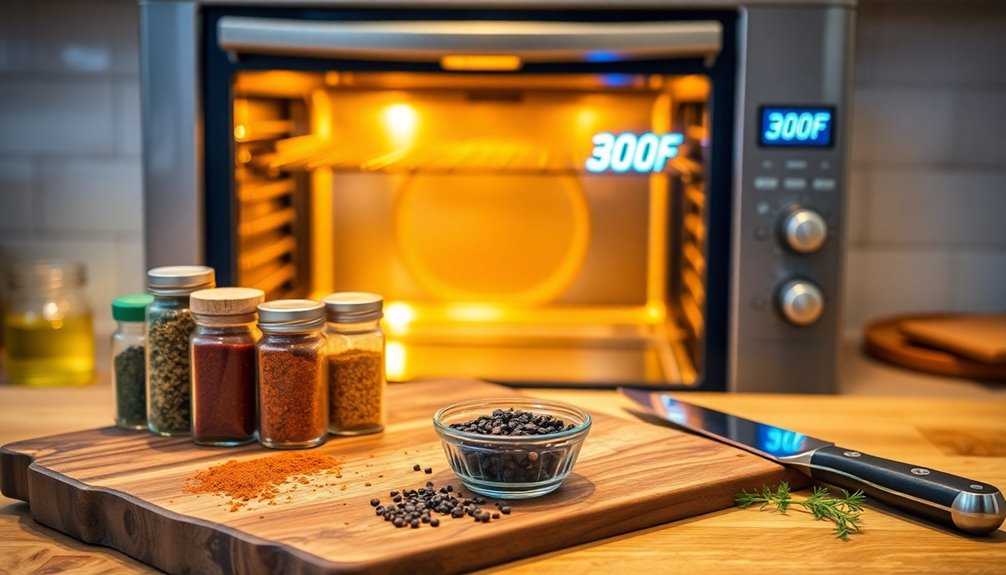
Before you start roasting, preheat your oven to 300°F. This low temperature is crucial for cooking pastrami, as it helps retain moisture and tenderness while allowing the flavors to fully develop.
Once the oven reaches the desired temperature, you can place the pastrami inside. To prevent it from drying out, cover it with foil during the initial cooking phase. Aim for an internal temperature of around 190-205°F; this ensures optimal tenderness. Additionally, using a meat thermometer will help you accurately gauge the doneness of the pastrami.
The combination of a low cooking temperature and careful monitoring will lead to a flavorful final product. Remember, once it's done, let the pastrami rest to redistribute its juices, enhancing that juicy, delicious taste you're aiming for.
Step 2. Season With Black Pepper
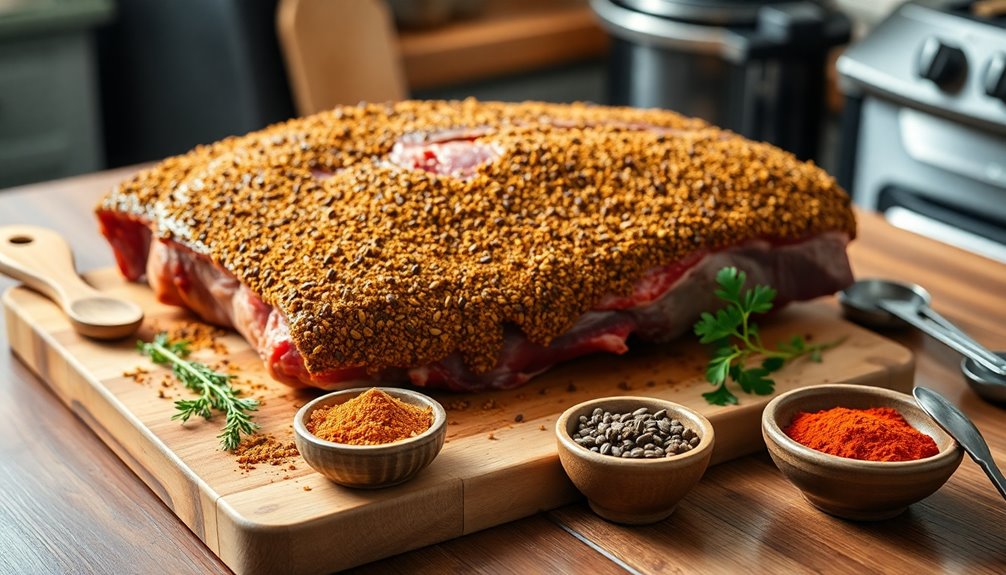
As you prepare to season your pastrami, remember that black pepper plays a crucial role in creating that signature flavor profile.
Start by toasting whole black peppercorns to enhance their essential oils, then grind them finely. For your pastrami recipe, use about 1 to 2 tablespoons of black pepper per pound of meat.
Mix this with other spices to form a rub that you'll apply generously. This creates a flavorful crust that adds texture during cooking.
Once seasoned, wrap the pastrami and let it rest in the refrigerator overnight. This step allows the black pepper and spices to penetrate the meat, ensuring a tender, flavorful outcome.
You'll love the depth of flavor this simple seasoning step brings! Additionally, incorporating African influence in your spice blend can add an exciting twist to your pastrami.
Step 3. Wrap in Butcher Paper
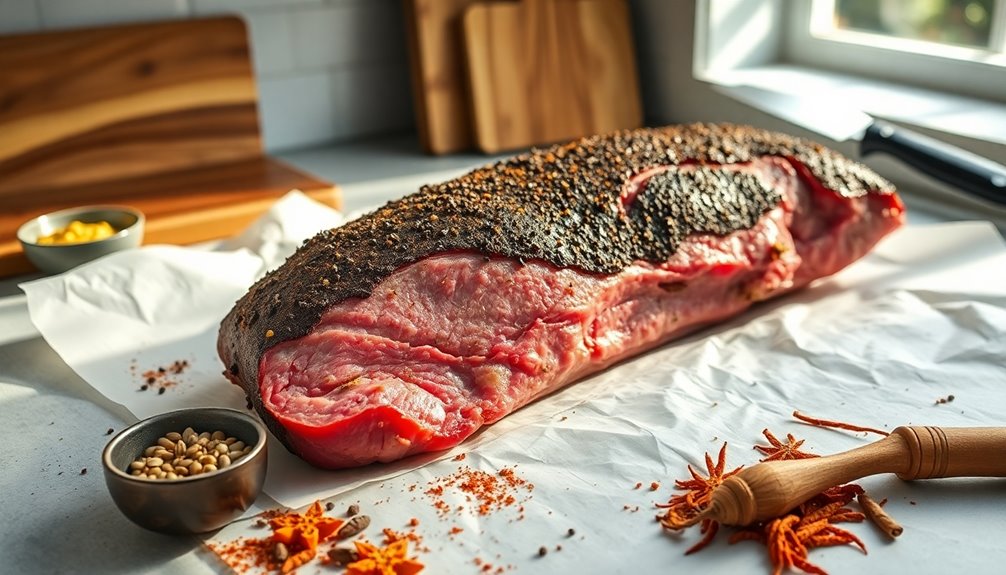
After seasoning your pastrami and allowing it to rest, it's time to wrap it in butcher paper.
Tightly wrap the pastrami to retain moisture and encourage a flavorful bark during the final cooking phase. Make sure the butcher paper is breathable, letting steam escape while keeping the meat tender.
Maintain a cooking temperature of around 250°F as you continue cooking, allowing the pastrami to reach an internal temperature of 205-210°F. Cooking it wrapped for an additional 2-3 hours enhances both texture and flavor, yielding a juicy, fall-apart consistency. Additionally, using a high Clean Air Delivery Rate air purifier in your kitchen can help eliminate any lingering odors while you cook.
Once it's done, let the wrapped pastrami rest for at least 30 minutes to maximize tenderness before slicing against the grain. Enjoy your delicious creation!
Step 4. Bake for Four Hours
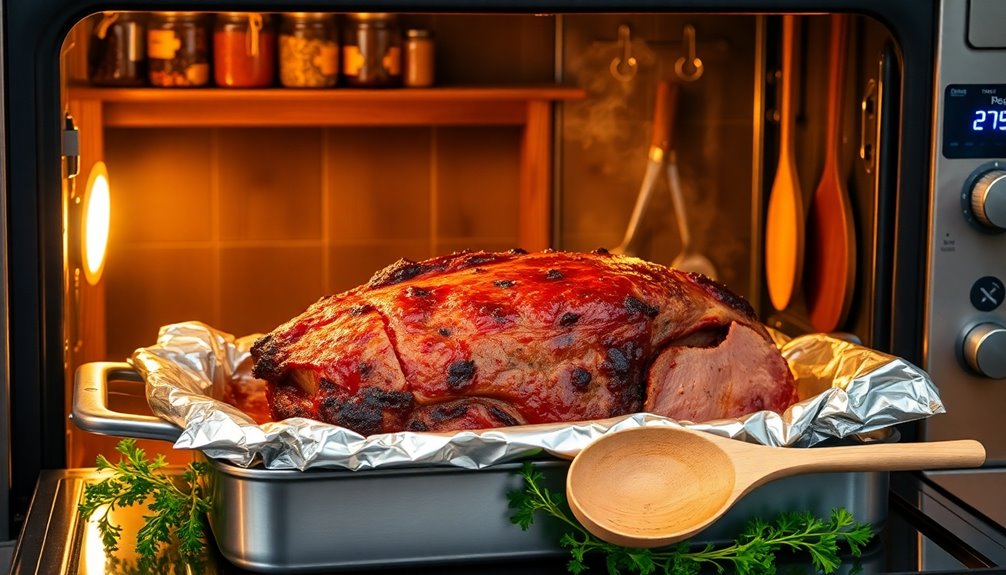
To achieve tender, fall-apart pastrami, you'll want to bake it for four hours at a steady 275°F (135°C).
Start by preheating your oven, ensuring it's ready for the pastrami roast. Wrap the seasoned beef brisket tightly in foil, which helps maintain moisture throughout the long baking process.
Then, place the wrapped brisket in the oven and let it bake for four hours. Keep an eye on the internal temperature, aiming for around 190°F (88°C) for that perfect tenderness.
Once done, it's essential to let the beef cool to room temperature. After cooling, you can rest it in the refrigerator, preparing it for slicing and serving later. This step is crucial for the best texture and flavor. Additionally, serving pastrami with healthy fats can enhance its nutritional profile.
Step 5. Rest for 30 Minutes

Once your pastrami has finished baking and cooled to room temperature, it's time to let it rest for 30 minutes.
This crucial step allows the juices to redistribute throughout the meat, enhancing its tenderness and flavor.
During this time, avoid wrapping the pastrami tightly; you want to prevent steam from making the exterior soggy.
Letting it rest also stabilizes the internal temperature, which improves the overall texture when you start slicing.
After the 30 minutes are up, slice against the grain for the best results.
This technique ensures each piece is tender and easy to chew, maximizing your enjoyment of the delicious pastrami you've prepared.
Additionally, maintaining a clean environment can help enhance your cooking experience by preventing any distractions or contamination.
Enjoy those flavorful bites!
Final Thoughts
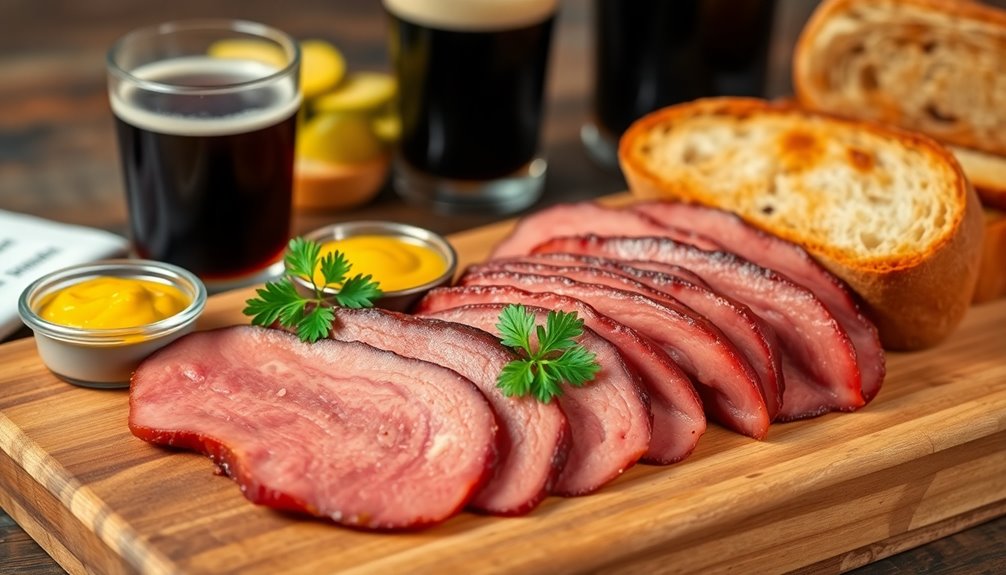
While you might think that making long roasted pastrami is a daunting task, the process is actually quite rewarding.
By starting with a thorough brining process lasting 5 to 7 days, you enhance the meat's moisture and flavor. The slow cooking at 275°F for about 6 hours ensures optimal tenderness, while the spice rub, featuring black pepper, smoked paprika, and coriander, develops rich flavors as it rests overnight.
After roasting, steaming the pastrami for an additional hour makes it fall-apart tender. Remember, cutting against the grain is crucial; it maximizes tenderness and elevates your overall eating experience. Additionally, serving your pastrami alongside cheesy polenta can create a deliciously complementary dish that enhances the flavors of both.
With a little patience and care, you'll create a delicious pastrami that's well worth the effort!
Frequently Asked Questions
How Long Do You Cook Pastrami in the Oven?
To cook pastrami in the oven, you'll want to bake it at a low temperature of 275°F for about 6 hours, wrapped in foil.
After that, steaming it for roughly 1 hour will help enhance its moisture and flavor.
Overall, you're looking at around 7 hours of cooking time.
Just be sure to check the internal temperature, aiming for 205-210°F for the best texture before slicing against the grain.
How Long Does Katz Smoke Their Pastrami?
Imagine biting into a tender, flavor-packed pastrami sandwich that's the talk of the town.
At Katz's Delicatessen, they smoke their pastrami for about two hours at a steady 250°F. This method infuses the meat with that iconic taste you crave.
After smoking, they steam it to keep it juicy and tender, ensuring it's perfect for slicing.
Is Pastrami Basically Corned Beef?
Pastrami isn't just corned beef; it's got its own unique flair.
While both come from beef brisket and undergo brining, pastrami's seasoned and smoked, giving it that distinct smoky flavor you love.
Corned beef lacks this smoking phase and is typically boiled.
So, when you enjoy pastrami, you're savoring a more complex taste experience.
It's that extra spice rub and smoking process that sets pastrami apart from its corned beef cousin.
How Long to Smoke Pastrami at 225?
Did you know that smoking can enhance the flavor of meat by over 300%?
When you smoke pastrami at 225°F, you'll want to plan for about 6 to 8 hours, depending on thickness. Aim for an internal temperature between 195°F and 205°F for that perfect tenderness.
Using a water pan helps keep things moist, so don't skip that step.
Remember to rest it for at least 30 minutes before slicing for juicy results!
Conclusion
In conclusion, long roasted pastrami isn't just a delicious treat; it embodies a rich history that weaves together cultures and culinary techniques. While some claim the secret lies in the slow-cooking method, others argue that the quality of the meat plays a crucial role. Ultimately, it's a delightful blend of both that creates the perfect bite. So, next time you savor this delicacy, remember it's not just food—it's a testament to tradition and flavor.
